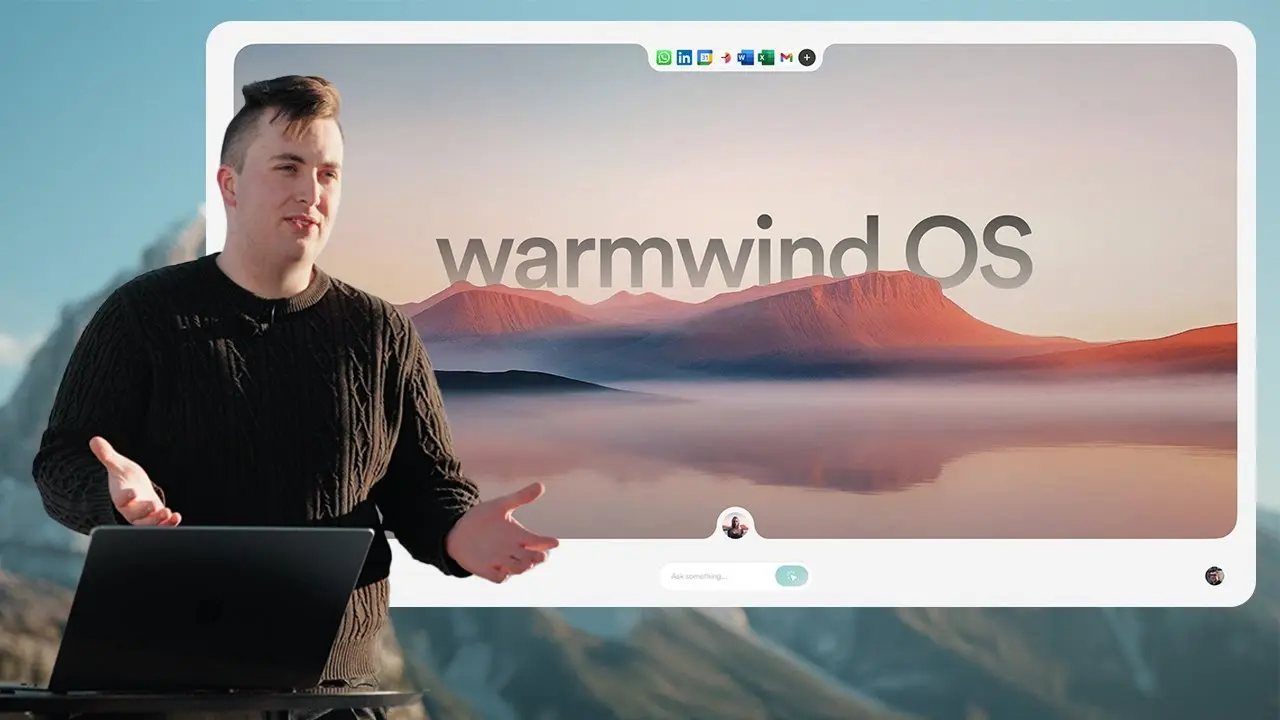So there’s a new relatively-small AI startup in tech town! Presenting Warmwind OS! A brand new gimmick, just kidding.
What is Warmwind OS?
Imagine if your computer could watch you work and then do that same work for you, over and over again. That’s the big idea behind Warmwind OS, a completely new operating system that promises to free you from boring, repetitive tasks at work.
Richard, the founder, talks about Warmwind like it’s going to change the world in the same way the printing press, computers, and the internet did. He’s building what he calls “autonomous cloud employees” that live inside this special operating system. Think of them as digital workers who never get tired, never make mistakes, and can handle the mind-numbing stuff that eats up your day.
The company isn’t just another startup with a fancy website. They’re serious about privacy and security, especially for European customers who care deeply about data protection. All of their systems run on German cloud servers, which means they follow Europe’s strict privacy laws called GDPR. This isn’t just a technical choice, it’s a business strategy aimed at companies that can’t risk their data ending up in the wrong hands.
How It Actually Works
Here’s where Warmwind gets really interesting. Instead of programming these digital workers with complex code, you simply show them what to do once. You record yourself going through a workflow, clicking buttons, filling out forms, moving data around. The system watches and learns. After that, it can repeat those exact same steps whenever you need it to.
Let’s say you work in customer service and spend two hours every morning copying support tickets from one system to another. With Warmwind, you’d record yourself doing this task once. From then on, your digital employee handles it automatically while you focus on actually solving customer problems instead of moving data around.
The technology works by controlling your mouse and keyboard just like a human would. It can read what’s on your screen, click buttons, type text, and navigate between different programs. When you watch the demo videos, it’s almost unsettling how human-like the interactions look. The digital worker doesn’t just blast through forms at computer speed. It pauses, moves the mouse naturally, and even seems to “think” before making decisions.
The Business Behind the Buzz
Warmwind recently came out of stealth mode, which means they stopped working in secret and started talking publicly about what they’re building. They announced that 12,000 people have signed up for their waiting list, which is impressive for a company most people have never heard of.
But here’s what’s really telling about their approach: they’re not rushing to market with a half-baked product. Instead, they’re running a closed beta, carefully choosing which customers get early access. This suggests they understand that their technology needs to work perfectly before regular businesses will trust it with important tasks.
The company is positioning itself as a premium solution for businesses that need rock-solid reliability and privacy. They’re not trying to compete with consumer apps or free tools. They’re going after companies that are willing to pay serious money for automation that actually works and keeps their data safe.
The Big Problem with Big Dreams
Now here’s where things get tricky, and why I think Warmwind might be making a costly mistake. To use their digital employees, you have to run their entire operating system. This means either replacing your current computer setup entirely or running Warmwind as a virtual machine inside your existing system.
Think about what this means for a typical office worker. First, you need to download a disk image file. Then you need to create a partition on your hard drive or set up a virtual machine. Next, you have to migrate all your apps, fonts, and security tools. Finally, you need to convince your IT department that this is a good idea. Each of these steps creates a barrier, and barriers kill adoption.
Meanwhile, companies like Anthropic are building similar technology that works inside your existing web browser. Claude’s Computer Use feature can control your screen just like Warmwind’s agents can, but you don’t need to install anything new. You just open a browser tab, give it permission, and you’re ready to go. When Fireship made a YouTube video about Claude’s feature, it got a million views in 48 hours because it was so easy for people to try.
The problem isn’t that Warmwind’s technology is bad. Actually, it might be better than the alternatives because they control the entire software stack. But better technology doesn’t always win. History is full of superior products that lost because they asked too much of their users.
Why Convenience Usually Wins
Here’s the thing about office workers: they’re already overwhelmed. They don’t want to learn a new operating system, no matter how amazing it might be. They want solutions that fit into their existing workflow with minimal disruption.
When your digital employee inevitably breaks down, which all software does, users will find themselves stuck in an unfamiliar environment trying to fix things. If Warmwind were just a regular app that ran alongside their familiar programs, getting back to work would be simple. But when the entire operating system is different, every problem becomes a bigger problem.
Let’s compare this to how other companies are tackling the same challenge. Claude’s Computer Use runs in any web browser and leverages the operating system you already trust. OpenAI’s GPT-4o Desktop runs as a regular app with local caching and works across different platforms. Open source tools like AutoGen work with existing developer workflows. All of these alternatives meet users where they already are instead of asking them to move somewhere new.
The Missed Opportunity
Warmwind’s Medium post mentions those 12,000 people on their waiting list, which sounds impressive until you realize there are over a billion Windows computers in the world that they’re completely ignoring. They’re building for a tiny slice of the market when they could be building for everyone.
Imagine if instead of a full operating system, Warmwind built a simple companion app. It could be a small program that runs alongside Outlook, SAP, or whatever software people already use. They could offer a free tier with five automated tasks per month, just enough to let people experience the magic. Then they could upsell to enterprise customers with the same German cloud infrastructure and privacy protections, but without the headache of managing a completely different operating system.
Yes, this approach would mean giving up some control and risking that bigger companies might copy their ideas. But it would also mean ten times more people could discover and use their technology. And in the business world, traction often matters more than perfection.
Questions That Need Answers
There are some important questions that Warmwind hasn’t answered yet. Will their digital employees ever be able to work with software installed on your regular computer, or are they forever trapped in their own operating system? When something goes wrong, how easy is it for a human to step in and fix the problem? Can other developers build on top of their teaching mode feature, or is it a closed system?
These questions matter because they reveal whether Warmwind is building a platform that can grow and adapt, or just a very sophisticated demo that works well in controlled conditions.
The Bottom Line
Richard’s launch video shows real conviction, and I genuinely hope his team succeeds. Anyone working to eliminate the soul-crushing busy work that fills our days deserves support. The technology they’ve built is genuinely impressive, and their focus on privacy and security addresses real concerns that businesses have.
But operating systems are like religions. People develop deep emotional attachments to their computing environment, and converting them to something new requires extraordinary effort. Even Apple, with all their marketing power and loyal customers, has only convinced a small percentage of computer users to switch from Windows.
If Warmwind wants to win hearts and maybe attract a big acquisition offer, they should consider coming down from the mountain and setting up shop where users already live. The valleys are crowded, but that’s where the people are.
Until then, I’ll keep my virtual machine ready for testing, but I’ll stick with my familiar operating system for real work. Sometimes the best technology isn’t the one that does everything perfectly. Sometimes it’s the one that does just enough, right where you need it, without asking you to change your entire world.



